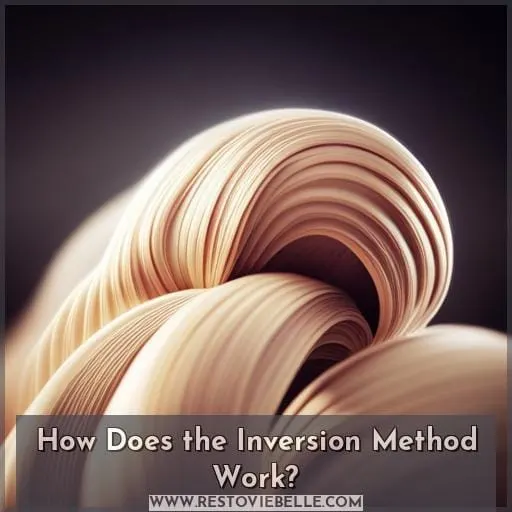This site is supported by our readers. We may earn a commission, at no cost to you, if you purchase through links.
 Uncover the secrets to luscious locks with the inversion method for hair growth.
Uncover the secrets to luscious locks with the inversion method for hair growth.
This technique harnesses the power of gravity to stimulate hair follicles and promote rapid growth.
Experience the transformative effects of increased blood flow and scalp nourishment as you embark on a journey toward thicker, healthier hair.
Prepare to unveil the hidden potential of your crowning glory with this innovative and evidence-based approach to hair growth.
Table Of Contents
- Key Takeaways
- What is the Inversion Method?
- How Does the Inversion Method Work?
- Does the Inversion Method Really Work for Hair Growth?
- Is the Inversion Method Safe?
- Choosing the Right Oil for the Inversion Method
- Applying Oil and Scalp Massage
- Proper Technique and Post-Inversion Care
- Frequently Asked Questions (FAQs)
- What are some alternative methods to the inversion method for promoting hair growth?
- How often should the inversion method be performed for optimal results?
- Can I use the inversion method with extensions or braids in my hair?
- Are there any specific foods or supplements that may enhance the effectiveness of the inversion method?
- Are there any potential side effects of using the inversion method for hair growth?
- Conclusion
Key Takeaways
- The inversion method is a technique that aims to promote hair growth by increasing scalp blood flow through head inversion.
- The method involves hanging upside down for a certain period of time, either using a specialized inversion table or by hanging from a bar or hook.
- While anecdotal evidence suggests that the inversion method can be effective, there is limited scientific research to support its efficacy.
- It is essential to consult with a healthcare professional before trying the inversion method, especially if you have any underlying health conditions.
What is the Inversion Method?
By hanging upside down, you’re trying to increase blood flow to your scalp, which may stimulate hair growth. This is the essence of the inversion method, an internet phenomenon that claims to accelerate hair growth.
Nevertheless, anecdotal evidence suggests that the inversion method, coupled with scalp massage, may stimulate hair follicles and promote hair growth.
Scalp massage, a key component of the inversion method, has been shown to increase hair thickness. A 2016 study demonstrated that standardized scalp massage resulted in increased hair thickness. Additionally, a larger survey indicated that scalp massage can help stabilize hair loss.
These findings suggest that scalp massage may play a role in improving hair health.
The inversion method incorporates scalp massage with the belief that the increased blood flow to the scalp during inversion enhances the benefits of scalp massage.
How Does the Inversion Method Work?
When you invert your head, you increase blood flow to your scalp.
This brings more oxygen and nutrients to your hair follicles, which stimulates them to produce thicker, healthier hair.
There’s some evidence that scalp massages can also help to improve hair growth.
Blood Flow to the Scalp
With the inversion method, hanging upside down increases blood flow to your scalp, which can stimulate hair follicles and promote hair growth.
While the effectiveness of the method varies among individuals, proper positioning and the use of essential oil blends can enhance its potential benefits.
Alternative approaches, such as scalp massage and a balanced diet, may also contribute to healthier hair growth.
Stimulation of Hair Follicles
You’ll stimulate your hair follicles often by increasing blood flow to your scalp with the inversion method.
This enhanced blood circulation delivers vital nutrients and oxygen to your follicles, promoting hair growth.
The inversion method also improves scalp health, which is crucial for hair growth prevention.
By nurturing your scalp and follicles, you create an environment conducive to hair growth, potentially reversing alopecia and activating dormant follicles.
Does the Inversion Method Really Work for Hair Growth?
Let’s investigate the evidence to determine if the inversion method lives up to its claims of accelerated hair growth.
Despite anecdotal evidence and personal success stories, scientific proof remains elusive.
Absence of Long-Term Studies:
- No long-term studies have examined the effectiveness of the inversion method on hair growth.
- Without such research, it’s impossible to draw definitive conclusions about its efficacy.
Conflicting Personal Experiences:
- While some individuals swear by the inversion method, others report no noticeable results.
- This inconsistency suggests that the method may not be universally effective or that individual factors play a role in its success.
Alternative Methods and DIY Variations:
- The inversion method is just one among many hair growth techniques.
- Other methods, such as scalp massage, essential oil treatments, and a balanced diet, have also shown promise in promoting hair health.
Is the Inversion Method Safe?
Before trying the inversion method, you must consider potential risks.
Particularly if you have health conditions like high blood pressure or heart disease.
Inversion can increase blood pressure, so it’s crucial to proceed with caution.
Consult your doctor if you have any concerns.
Potential Risks and Side Effects
Potential risks and side effects may arise from the inversion method:
- Dizziness, nausea, and scalp irritation can occur.
- Be cautious if you have heart disease or high blood pressure.
- Consult your healthcare provider before trying the inversion method for hair growth.
Body inversion can increase blood pressure, so it’s not recommended for everyone.
Precautions for Individuals With Health Conditions
If you have high blood pressure or heart problems, consult your doctor before trying the inversion method.
Proceed gradually to prevent dizziness or discomfort.
Individuals with certain medical conditions, like glaucoma or spinal injuries, should avoid the inversion method.
Nurture yourself with inside-out care. Always prioritize safety when trying natural remedies.
Choosing the Right Oil for the Inversion Method
Now that you’re aware of the safety considerations, let’s delve into the art of selecting the ideal oil for your inversion method ritual.
Your choice of oil plays a pivotal role in optimizing the treatment’s effectiveness while pampering your scalp.
Consider Oil Properties:
-
Opt for oils renowned for their hair-friendly properties, such as coconut oil’s moisturizing prowess, castor oil’s ability to combat hair loss, and argan oil’s damage-repairing qualities.
Prioritize Natural Oils:
-
Embrace the goodness of natural oils like olive, jojoba, and grapeseed oil. These oils are less likely to irritate your scalp and may even promote hair growth.
Choose a Soothing Aroma:
- Engage your senses by selecting an oil with a calming aroma that complements your inversion method’s relaxation-focused approach.
Applying Oil and Scalp Massage
After selecting your oil, gently massage it into your scalp using circular motions with your fingertips and palms.
This will help stimulate blood flow and promote hair growth.
Start with a small amount of oil and gradually increase it as needed.
For a sensitive scalp, choose oils like coconut, avocado, or jojoba.
For best results, massage your scalp for at least 4-5 minutes, focusing on areas where you want to see the most growth.
| Oils for Sensitive Scalp | Scalp Massage Duration |
|---|---|
| Coconut Oil | 4-5 minutes |
| Avocado Oil | 4-5 minutes |
| Jojoba Oil | 4-5 minutes |
Trichologist Leata A. Williams suggests massaging the scalp for 4-5 minutes to stimulate hair growth.
She also recommends using essential oils like peppermint or lavender for their invigorating properties.
If you’re short on time, try the semantic inversion method, which involves visualizing your hair growing longer and thicker while massaging your scalp.
For a full-body inversion, find a comfortable place to invert, like a handstand or inversion table, and hang upside down for 3-5 minutes.
Proper Technique and Post-Inversion Care
With your oil-infused scalp, let’s delve into the proper technique and post-inversion care.
Time your oil application wisely – ideally, an hour before inversion for optimal absorption.
Massage your scalp during inversion for enhanced blood flow and nutrient delivery to hair follicles.
Utilize inversion tables or modified positions for a comfortable and safe head-down experience.
After your inversion session, carefully return to an upright position to avoid dizziness.
Rinse your hair thoroughly with a mild shampoo to remove excess oil, preserving your scalp’s natural balance.
Engage in this ritual consistently, and you may witness a transformation in your hair’s vitality and growth.
Frequently Asked Questions (FAQs)
What are some alternative methods to the inversion method for promoting hair growth?
Unleash your crowning glory’s potential with alternative hair growth strategies.
Explore scalp massages, essential oil treatments, and dietary adjustments to awaken dormant follicles and reclaim your vibrant, voluminous mane.
Scalp massages stimulate blood flow, promoting hair growth. Essential oil treatments, like rosemary and peppermint, can invigorate the scalp and follicles. Dietary adjustments, such as increasing protein and biotin intake, can provide essential nutrients for healthy hair growth.
How often should the inversion method be performed for optimal results?
Unlock your crowning glory’s hidden potential with daily dedication to the inversion method.
Unleash a torrential surge of nutrients to your hair follicles, setting the stage for epic growth that’ll leave you spellbound.
Can I use the inversion method with extensions or braids in my hair?
Extensions and braids form a protective barrier, hindering oil penetration and scalp stimulation.
Remove them before the inversion method for optimal results and scalp health.
Are there any specific foods or supplements that may enhance the effectiveness of the inversion method?
Enhance the effectiveness of your hair growth regimen by incorporating a diet rich in vitamins, minerals, and omega-3 fatty acids.
Supplements like biotin and zinc can further amplify results.
Are there any potential side effects of using the inversion method for hair growth?
Using the inversion method may cause dizziness, nausea, and increased blood pressure.
It can strain your back and neck.
Consult your doctor before trying it, especially if you have heart disease, high blood pressure, or other health concerns.
Conclusion
With the inversion method for hair growth as your compass, navigate the uncharted territories of hair growth potential.
Feel the surge of blood flow nourishing your scalp, reawakening dormant follicles, and igniting a transformation that will leave you mesmerized.
Embrace this simple yet profound technique, and watch as your hair embarks on a journey to unprecedented lengths and vitality.













